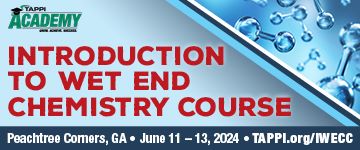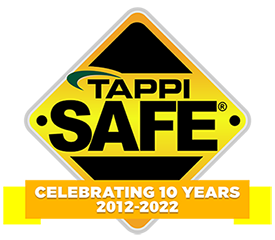 Search
Search
Use the search bar or filters below to find any TAPPI product or publication.
Filters
Content Type
Publications
Level of Knowledge
Collections
Journal articles

Magazine articles

Editorial: A closer look at the 2021 TAPPI Journal Best Research Paper, TAPPI Journal July 2022
ABSTRACT: Each year, the TAPPI Journal Editorial Board honors the best of the journal’s content by nominating and voting for the TAPPI Journal Best Research Paper, which is ultimately selected based on scientific merit, innovation, creativity, and clarity.
Journal articles

Magazine articles

On the usage of online fiber measurements for predicting bleached eucalyptus kraft pulp tensile index — an industrial case, TAPPI Journal July 2022
ABSTRACT: Cellulose pulp’s physical-mechanical properties are determined by laboratory tests obtained from prepared handsheets. However, this procedure is time intensive and presents a lead time until the results are available, hindering its utilization for monitoring and decision-making in a pulp mill. In this context, developing real-time solutions for physical-mechanical properties prediction is fundamental. This work applied a mathematical modeling approach to develop a soft sensor for tensile index monitoring. The mathematical model considers online morphology measurements obtained from the last bleaching stage outlet stream and important process variables for tensile index prediction. The results obtained are satisfactory compared to laboratory results, presenting a mean absolute percentual error of 2.5%, which agrees with the laboratory testing method’s reproducibility.
Journal articles

Magazine articles

Investigation of the Cellulose-Water Relationship by the Pressure Plate Method, TAPPI Journal July 2022
ABSTRACT: The swelling and water retention properties of pulp fibers are of basic importance in papermaking.
Journal articles

Magazine articles

Does the kappa number method accurately reflect lignin content in nonwood pulps?, TAPPI Journal November 2018
Does the kappa number method accurately reflect lignin content in nonwood pulps?, TAPPI Journal November 2018
Journal articles

Magazine articles

In-process detection of fiber cutting in low consistency ref
In-process detection of fiber cutting in low consistency refining based on measurement of forces on refiner bars, TAPPI JOURNAL April 2017
Journal articles

Magazine articles

Editorial: Coating & Graphic Arts, Process Control papers ho
Editorial: Coating & Graphic Arts, Process Control papers honored at PaperCon, TAPPI JOURNAL June 2017
Journal articles

Magazine articles

Improving the efficiency of hydrogen peroxide bleaching of c
Improving the efficiency of hydrogen peroxide bleaching of chemimechanical pulp by continuous replenishment of bleaching chemicals, TAPPI JOURNAL June 2017
Journal articles

Magazine articles

Reduction of alkali loss in an ash leaching system, TAPPI J
Reduction of alkali loss in an ash leaching system, TAPPI JOURNAL July 2017
Journal articles

Magazine articles

Evaluation of the particle size of organosolv lignin in the
Evaluation of the particle size of organosolv lignin in the synthesis of resol resins for plywood and their performance on fire spreading, TAPPI JOURNAL July 2017
Journal articles

Magazine articles

Comparative study of guar gum and its cationic derivatives as pre-flocculating polymers for PCC fillers in papermaking applications, TAPPI Journal April 2022
ABSTRACT: In this work, gums from guar seeds were evaluated as a potential precipitated calcium carbonate (PCC) filler pre-flocculant to induce functional filler in papermaking applications. In recent years, guar has been conidered one of the promising wet-end additives due to its abundance, rich source of hemicellulose content, and bio-degradability. However, application of guar gum in filler pretreatment methods for producing high ash paper has scarcely been reported. In this paper, the flocculating ability of three types of guar gum was established with charge analysis and turbidity (NTU) of the system at 1% and 5% for each gum: native gum (NG) having a degree of substitution (DS) of 0, and cationic gums having a DS value of 0.07 (CL) and 0.15 (CH). It was interesting to observe that even at a 5% dose of G, the charge density of PCC did not deviate much from the initial values. The system carried a weak negativeharge, resulting in an unstable colloidal suspension that led to PCC-PCC particle bridging. On the other hand, the operative mechanism of CL and CH during adsorption and PCC flocculation was predicted to be charge neutralization and electrostatic-patch formation, accompanied by particle bridging. Note that CL, with a maximum 47.5% eduction in residual turbidity of PCC at a 1% dose, was much more efficient in doing so than the other two gums; NG had a 40% maximum reduction in residual turbidity at a 5% dose and CH had a maximum 30% reduction at a 1% ose. Later on, floc formation and structure were correlated with optical and field emission scanning electron microscopy (FE-SEM) images. In the next set of trials, paper properties were determined by varying the different gum dosages from 0.2% to 5% at a constant dose of 20% filler. It is also noteworthy to mention that with 1% CL (low DS) dose, PCC retention increased by 39%, which also enhanced the tensile, tear, burst, and opacity properties by 11%, 19%, 5%, and 4.4%, respectively, without significantly affecting the bulk properties. Further, wide-angle X-ray diffraction (XRD) analysis nd Fourier transform infrared (FTIR) analysis revealed that pre-flocculating PCC with a 1% gum dose did not induce any change in crystalline transformation. Based on observation, it was found that cationic gums with low DS values re a better choice for maximizing the strength of paper while maintaining bulk and high opacity when pre-flocculaion is adopted to increase the filler retention in paper.






